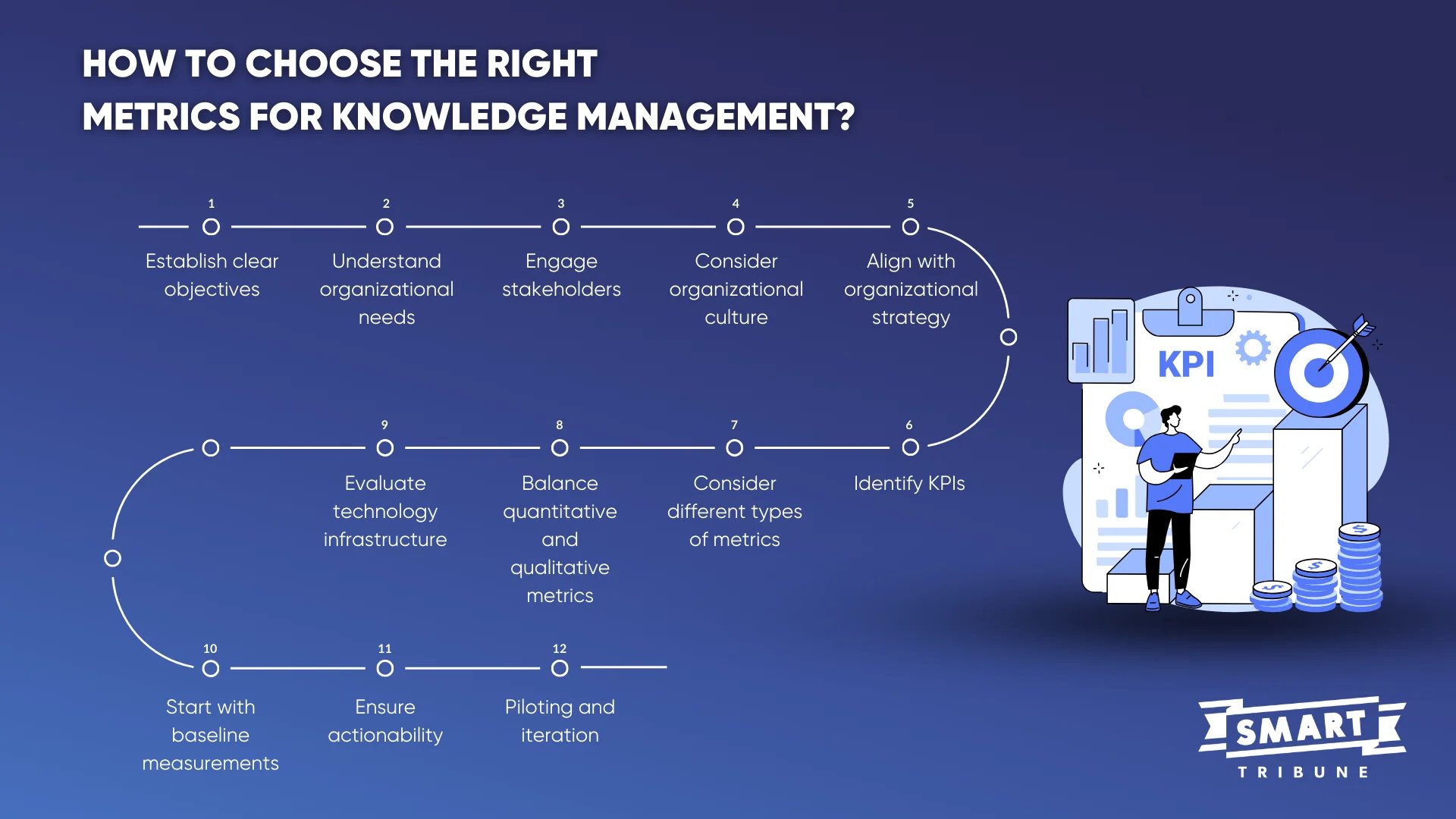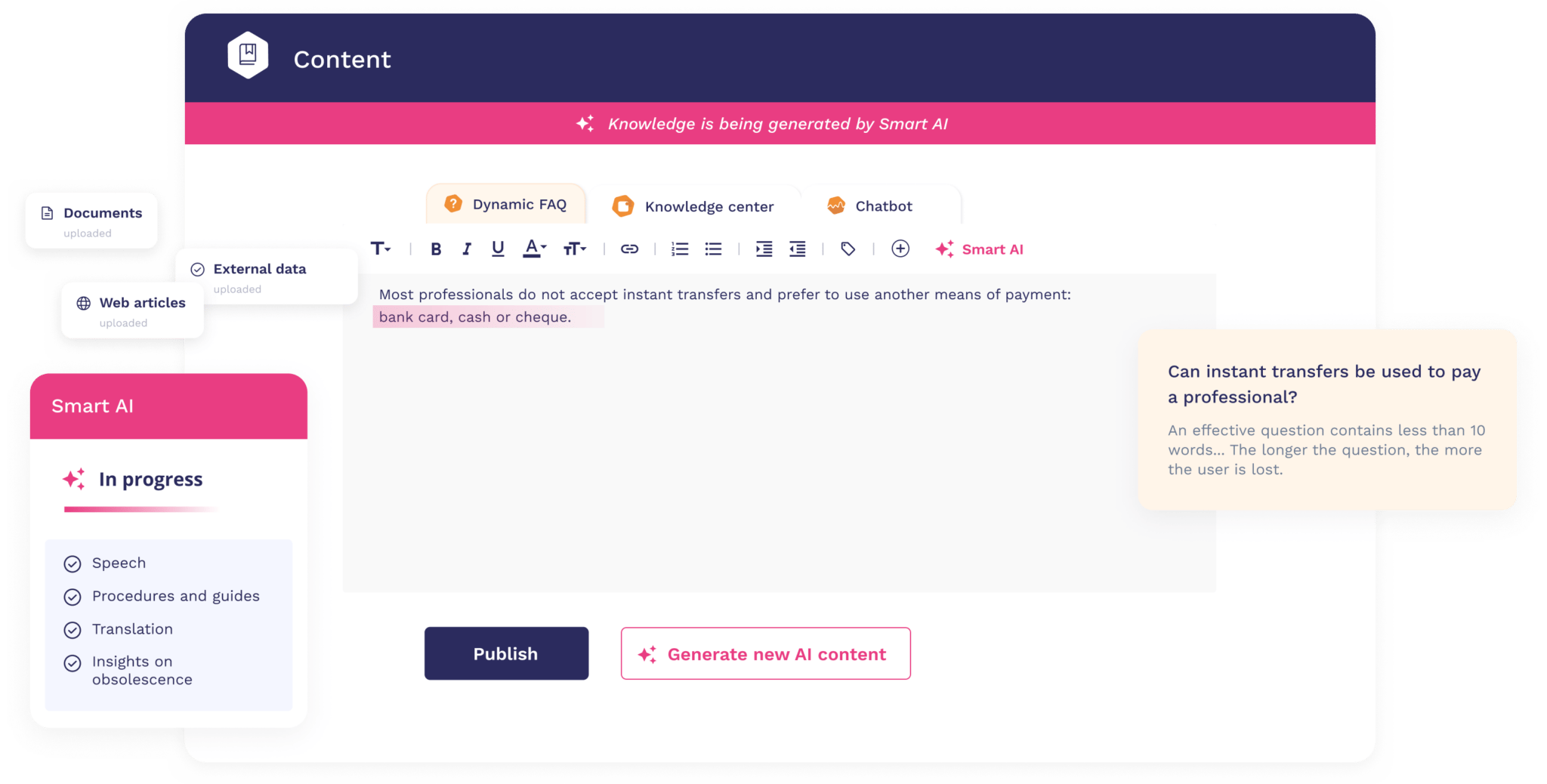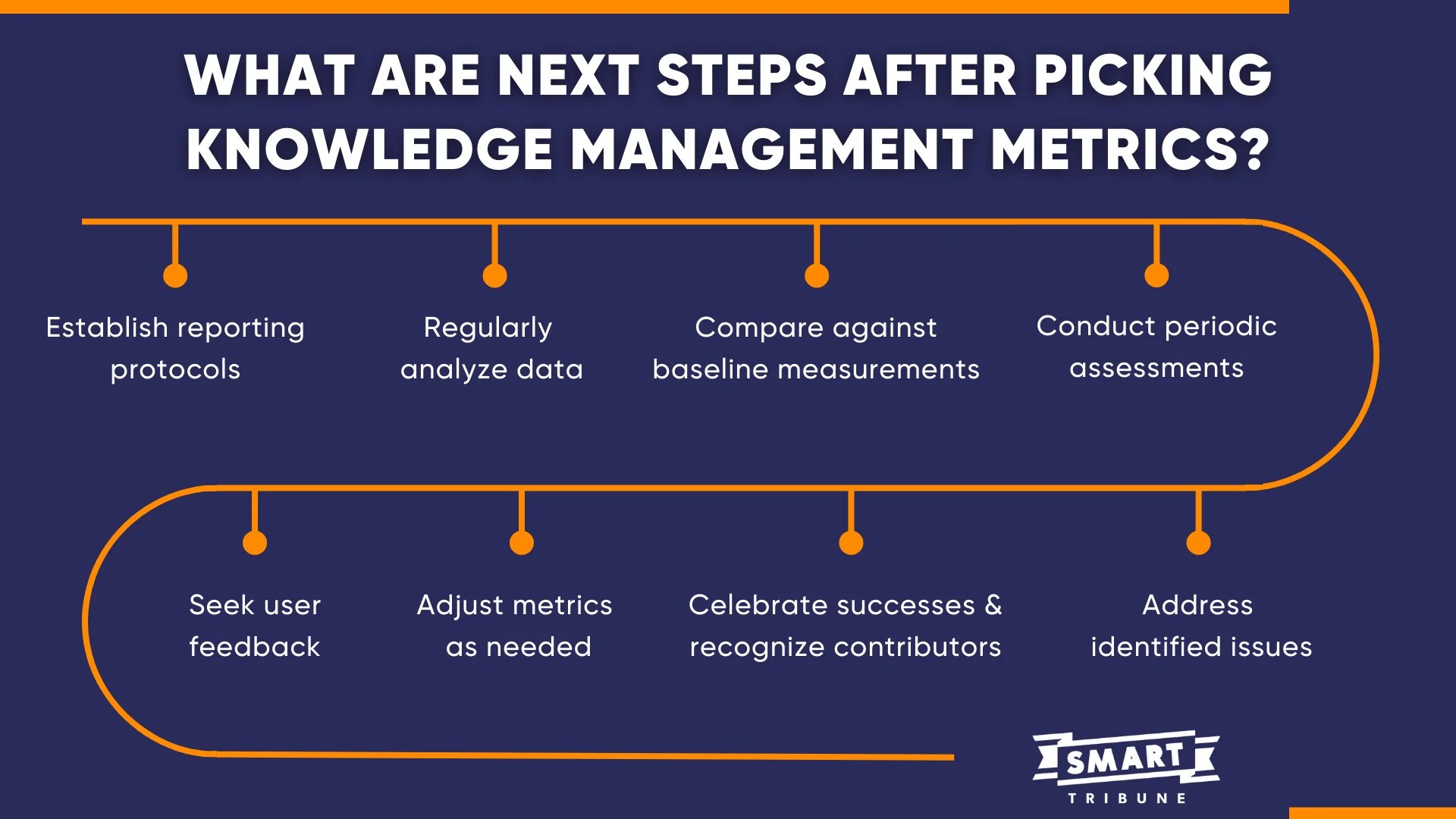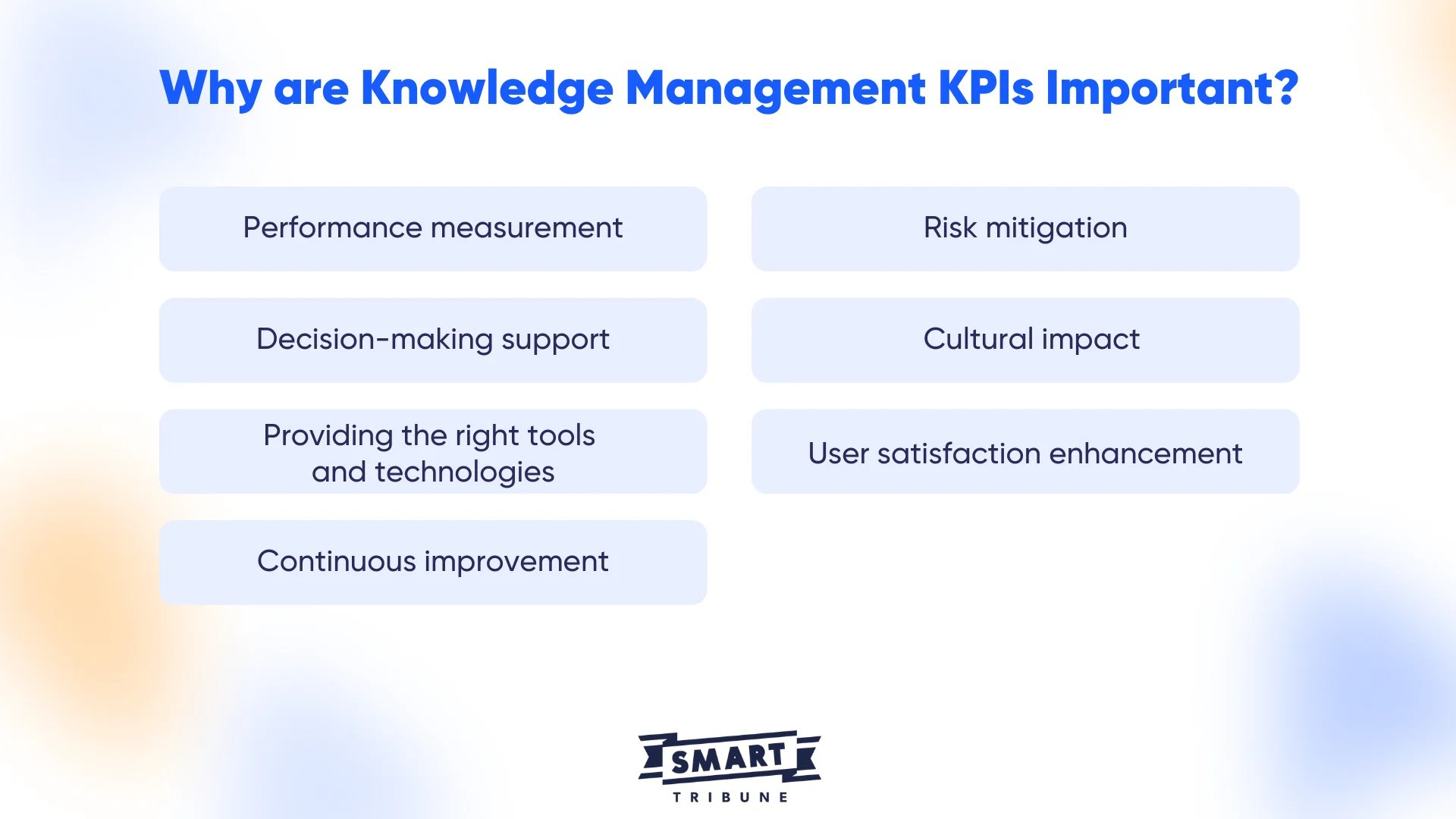
On DECEMBER 4, 2023
11 Essential Knowledge Management Metrics and KPIs for Your Organisation
In the intricate dance of organizational knowledge, imagine the plight of a knowledge manager navigating a labyrinth without a map. The absence of knowledge management metrics is akin to embarking on a journey blindfolded, where every decision becomes a shot in the dark.
Understanding that you're struggling with managing knowledge in the workplace, in this article, Smart Tribune will walk you through
- Top 11 strategic KM metrics and examples,
- Ultimate guide to picking the right metrics and setting KPIs,
- Steps to take after selecting KM metrics,
- Digestive definition of knowledge management metrics,
- Role of KM metrics,
- FAQs about KM metrics for managers.
Let's get the ball rolling!
11 Knowledge Management Metrics That Businesses Should Consider in 2024
Effective knowledge management is crucial for businesses to leverage their intellectual capital and enhance overall performance. To gauge the success and impact of knowledge management initiatives, businesses should consider various metrics that are accurately defined in the following table.
|
Sorts of Metrics |
KM Metrics Example |
Purpose |
|
Access and Usage Metrics |
- Page views, - Unique visitors, - Frequency of knowledge usage |
Evaluate the accessibility and utilization of knowledge resources within the organization. |
|
Contribution and Engagement Metrics |
- Number of contributions, - User feedback and ratings, - Participation rates |
Assess the level of employee engagement and active participation in sharing insights. |
|
Quality and Accuracy Metrics |
- User ratings and feedback, - Accuracy assessments, - Timeliness of information updates |
Gauge the quality and relevance of shared knowledge to ensure its value for users. |
|
Efficiency Metrics |
- Time to find information, - Resolution time for issues, - Efficiency of search functionalities |
Measure the efficiency of knowledge retrieval and problem-solving processes. |
|
Retention and Succession Metrics |
- Employee retention rates, - Preservation of critical knowledge during turnover |
Evaluate the organization's ability to retain and transfer knowledge despite changes in personnel. |
|
Collaboration Metrics |
- Frequency of collaboration on shared documents, - Successful teamwork on projects |
Assess the impact of knowledge sharing on collaborative efforts and collective outcomes. |
|
Learning and Development Metrics |
- Training completion rates, - Documented instances of skill improvement |
Measure the contribution of knowledge sharing to continuous learning and employee development. |
|
Innovation Metrics |
- Number of innovative ideas generated, - Successful innovations |
Evaluate the role of knowledge sharing in fostering a culture of creativity and innovation. |
|
Cost Savings and Resource Metrics |
- Reduction in time spent searching for information, - Resource savings |
Demonstrate the tangible benefits and cost-effectiveness of efficient knowledge management. |
|
Employee Satisfaction and Cultural Metrics |
- Adoption rates of knowledge-sharing platforms, - Alignment of knowledge initiatives with organizational values |
Measure the impact of knowledge sharing on employee satisfaction and organizational culture. |
|
Strategic Metrics |
- Alignment of knowledge initiatives with business objectives, - Impact on strategic goals |
Assess how knowledge management initiatives contribute to overall strategic objectives. |
How to Choose the Right Metrics for Knowledge Management?
Choosing the right metrics for knowledge management involves a strategic and thoughtful process to ensure that the selected indicators align with organizational goals and accurately measure the effectiveness of knowledge-sharing initiatives. Here's a step-by-step guide to help you choose the right metrics.

Establish clear objectives
The journey begins with clarity. Leaders should define the objectives of the knowledge management initiative with precision. Whether it's fostering collaboration, enhancing decision-making, or nurturing innovation, well-defined goals are the north star guiding your metric selection.
Understand organizational needs
Knowledge managers should dive deep into the organizational landscape by conducting a comprehensive assessment of the company's challenges, priorities, and unique needs.
This phase helps identify areas where KM can make a tangible impact, acting as a strategic solution rather than a mere process.
Engage stakeholders
Knowledge is a collective asset, and so is the process of metric selection. That's why key stakeholders, from top-level executives to end-users should engage in. Their diverse perspectives will enrich the metric selection process and ensure alignment with the broader organizational vision.
Consider organizational culture
Organizations, like individuals, have unique cultures. Knowledge managers may tailor the metrics to align with this cultural DNA.
If collaboration is the heartbeat of your company, focus on metrics that illuminate team-based knowledge sharing and foster a collaborative ethos.
Align with organizational strategy
Metrics should not operate in isolation but harmonize with the overarching organizational strategy. Ensure that each selected metric contributes meaningfully to broader business objectives, reflecting the profound impact of KM on strategic goals.
Identify key performance indicators (KPIs)
KPIs are doubtlessly your compass, navigating the way to KM excellence. Metrics should meet SMART criteria, which means
- Specific,
- Measurable,
- Achievable,
- Relevant,
- Time-bound.
Consider different types of metrics
The metric landscape is diverse. Exploring various types, from user engagement and content quality to collaboration, innovation, and overall impact on decision-making will help you paint a complete picture of your KM success.
Balance quantitative and qualitative metrics
Achieve equilibrium in your metrics portfolio. While quantitative metrics provide numerical precision, qualitative metrics, such as user feedback and satisfaction, add depth, offering insights into the human side of the KM story.
Evaluate technology infrastructure
Your chosen metrics must seamlessly integrate into your technological foundation. Knowledge managers are supposed to assess the existing infrastructure to ensure effective tracking and measurement.
In some cases, the person in charge might have to implement new tools if necessary for a cohesive KM ecosystem.
To avoid hassle down the road and mitigate risks, knowledge managers should thoroughly consider all-inclusive, reliable, robust and scalable knowledge base solutions, such as Smart Knowledge. With an AI-powered editor and sleek dashboard, businesses can save time and promote engagement with ease.
Don't just take our word for it, check out how other enterprises benefit from our knowledge base tool and give us a whirl to see a revolution in KM.

Start with baseline measurements
Lay a strong foundation by establishing baseline measurements. This historical snapshot serves as a benchmark, providing context for evaluating progress and understanding the evolving landscape of your KM strategy.
Ensure actionability
Metrics should not be mere observers; they should be catalysts for action. Select metrics that guide decision-making and highlight specific areas for improvement, transforming your KM strategy from a static plan into a dynamic force.
Piloting and iteration
Embark on a transformative journey by launching a pilot initiative, introducing your carefully chosen metrics on a more manageable scale. This approach not only facilitates nimble adjustments based on valuable feedback but also sets the stage for a dynamic culture of iteration.
Picture a landscape where your metric selection becomes a living entity, adapting and evolving harmoniously with the ever-changing needs of your organization. It's not just a pilot; it's a thrilling expedition into a realm of continuous improvement, ensuring your metrics stay finely tuned to steer your knowledge management strategy toward unprecedented success.
Verdict: Apparently, the selection of metrics for knowledge management is a strategic art, requiring a nuanced understanding of organizational dynamics. As you navigate this path, let your goals be clear, your stakeholders engaged, and your metrics a reflection of the vibrant tapestry of your organizational culture.
What Are Next Steps After Picking Knowledge Management Metrics?

- Develop a clear reporting protocol that outlines how data will be analyzed, interpreted, and reported to stakeholders.
- Establish regular reporting intervals to keep stakeholders informed about the progress of knowledge management initiatives.
- Regularly analyze the collected data to gain insights into user behavior, content relevance, and overall knowledge management effectiveness.
- Identify patterns, trends, and areas for improvement based on the analysis.
Compare current metrics against baseline measurements established before implementing knowledge management initiatives. This comparison helps gauge the impact and effectiveness of the knowledge management strategy over time.
4. Conduct periodic assessmentsConduct periodic assessments of the knowledge management metrics to evaluate their ongoing relevance. As organizational needs evolve, ensure that the chosen metrics continue to align with strategic objectives.
5. Seek user feedbackActively seek feedback from users regarding their experience with the knowledge management platform. User feedback provides qualitative insights that complement quantitative metrics and helps refine strategies.
6. Adjust metrics as neededIf necessary, be open to adjusting or refining metrics based on evolving organizational priorities or changes in the business environment. Ensure that metrics remain aligned with the overall goals of the organization.
7. Celebrate successes and recognize contributors- Celebrate achievements and successes indicated by positive metrics.
- Recognize and reward individuals or teams that have contributed significantly to the success of knowledge management initiatives. Positive reinforcement encourages continued engagement.
Proactively address any issues or challenges identified through the analysis of metrics. Whether it's improving content quality, enhancing user engagement, addressing technical issues, or tackling device and accessory problems faced by employees, take corrective actions to optimize knowledge management processes.
What is Knowledge Management Metric?
A knowledge management metric is a quantifiable measurement used to assess and evaluate various aspects of knowledge management within an organization. These metrics provide insights into the effectiveness, efficiency, and impact of knowledge-related initiatives, helping organizations understand how well they are leveraging and managing their intellectual capital.
Knowledge management metrics cover a broad range of factors, from the accessibility and utilisation of information to the level of employee engagement in knowledge-sharing activities.

Why are Knowledge Management KPIs Important?
Knowledge management metrics are definitely the compass guiding businesses through the ever-evolving realm of information, transforming the intangible asset of knowledge into tangible insights. Let's find out what advantages knowledge management metrics ooze with.

Performance measurement
Knowledge KPIs have a crucial role to play in quantifying the success of knowledge management initiatives.
By providing measurable metrics, organizations can
- Assess how well their strategies are performing,
- Identify areas for improvement,
- Gauge the overall impact on efficiency and productivity.
Decision-making support
KPIs offer invaluable data-driven insights that support informed decision-making.
Leaders and decision-makers can leverage these metrics to make strategic choices, backed by concrete evidence of how knowledge management practices have an influence upon various aspects of the organization.
Continuous improvement
The significance of knowledge management metrics lies in their ability to highlight areas for improvement. With regular metric evaluation and analysis, organizations can
- Identify weaknesses,
- Refine knowledge management processes,
- Foster a culture of continuous improvement.
This course of action can substantially contribute to the efficiency of the knowledge management strategies.
Learn more about How to successfully develop a knowledge management strategy.
Employee engagement improvement
KPIs provide a quantifiable measure of employee engagement in knowledge-sharing activities. Understanding the level of participation helps organizations foster a culture where knowledge sharing is valued, recognized, and incentivized, contributing to a more engaged and collaborative workforce.
Check out 10 steps to improve knowledge sharing across your organisation.
Risk mitigation
KPIs play a preventive role in risk management by helping organizations identify and address potential challenges in knowledge management processes. Proactive risk mitigation ensures the integrity of shared information and reduces the likelihood of knowledge-related issues.
Cultural impact
KPIs can measure the impact of knowledge management on organizational culture. By assessing whether knowledge-sharing practices contribute to a collaborative and innovative culture, organizations can shape their strategies to reinforce positive cultural aspects within the workforce.
User satisfaction enhancement
Measuring user satisfaction with knowledge management systems is crucial for enhancing the overall user experience. KPIs in this regard provide insights into the effectiveness and usability of knowledge-sharing platforms, guiding improvements that directly impact user satisfaction.
FAQs about Metrics for Knowledge Management?
1. How to measure knowledge management success?
Measuring knowledge management success involves assessing key performance indicators, such as user engagement, content relevance, adoption rates, and impact on organizational goals. Quantifiable metrics, regular feedback, and alignment with strategic objectives provide insights into the effectiveness of knowledge-sharing initiatives. Success is measured by improved access to information, increased collaboration, and a positive impact on decision-making processes.
2. What are engagement metrics for knowledge management?
Engagement metrics for knowledge management include the number of contributions, user feedback and ratings, participation rates, frequency of collaboration, usage duration, adoption rates, click-through rates, time spent on the platform, interaction with content, and the active user ratio.
3. What is the importance of measurement and metrics to a knowledge management (KM) initiative?
Measurement and metrics are crucial to a Knowledge Management (KM) initiative as they provide quantifiable insights into the effectiveness, user engagement, and impact on organizational goals.
Key Takeaways from Leading Metrics for Process Knowledge Management
Metrics and KPIs are essential not only in knowledge management but also in other business strategies and execution. Knowledge management metrics serve as a tactical primer in guiding your team to knowledge management success. By selecting the suitable metrics, businesses will take full advantage of the knowledge base and continuously improve it.
Undoubtedly, picking a powerful, feature-rich and user-friendly knowledge management tool like Smart Knowledge will give you an upper hand in preserving knowledge and making knowledge a secret weapon.
We hope that after reading this resource, you can define suitable knowledge management metrics for your team. Should you have any further inquiries or desire to give Smart Knowledge a shot, drop us a line for assistance.


.png)



